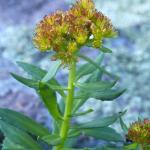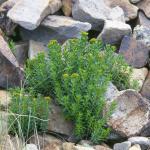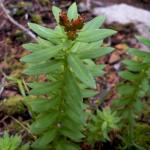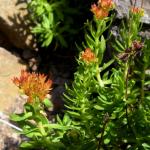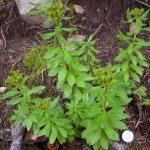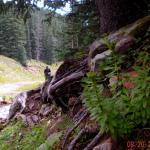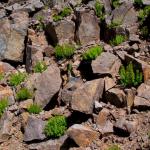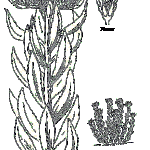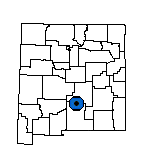Rhodiola integrifolia ssp. neomexicana (Alpine Sedum)
RHODIOLA NEOMEXICANA BRITTON; SEDUM ROSEUM VAR. NEOMEXICANUM (BRITTON) BERGER, RHODIOLA INTEGRIFOLIA SSP. NEOMEXICANA (BRITTON) H. OHBA
| USFWS | State of NM | USFS | BLM | Navajo Nation | State Rank | Global Rank | R-E-D Code | NMRPTC Status | Strategy Status |
|---|---|---|---|---|---|---|---|---|---|
| SEN | S2 | G5T2 | 3-1-3 | R | SS |
| Overall Conservation Status | Documented Threats | Actions Needed |
|---|---|---|
| MODERATELY CONSERVED | Fire & fire suppression |
Status surveys on abundance, distribution and threats |
Succulent perennial from a thick, fleshy rootstock; stems one to several, 2-23 cm tall; leaves sessile, alternate, coriaceous, glabrous and glaucous, obovate to oblanceolate, margins entire to sparsely dentate, 1.5-3 cm long and 4-7 mm wide; inflorescence a terminal, dense, flat-topped to somewhat rounded cyme; sepals 4-5, lanceolate, about 2 mm long; petals distinct, about 4 mm long and 1.5 mm wide, acute, yellow with reddish midvein, occasionally red in the upper half; stamens longer than the petals; fruit of 5 distinct follicles, 4-8 mm long, with recurved stylar beaks. Flowers late July through August.
Sedum integrifolium is distinguished from most other sedums by its broad, flat leaves. Sedum rhodanthum also has flat leaves, but is distinguished by its red paniculate inflorescence. Sedum integrifolium ssp. integrifolium and ssp. procerum occur in the mountains of northern New Mexico and have broader leaves and reddish-purple petals. Subspecies neomexicanum is distinguished in the species by it narrower leaves and yellow petals with red tips or midveins.
New Mexico, Lincoln and Otero counties, Sierra Blanca.
Igneous soils in alpine tundra, scree-slopes and rocky openings in subalpine forest; 3,000-3,600 m (9,900-11,800 ft).
Presently only known from the high elevations of Sierra Blanca. Plants at the highest elevations are relatively short and have more red pigment in their flowers. Those at about 3,000 m in elevation are more robust with almost entirely yellow petals.
Sierra Blanca is heavily used for recreational skiing and summer hiking. A few locations of New Mexico stonecrop occur within ski runs and on road cuts along the highway leading up to Ski Apache. The radio towers and access road on Buck Mountain also occur within this plant's habitat. These impacts are minor and several large, undisturbed populations on rocky, inaccessible ridges occur on the mountain.
Clausen, R.T. 1975. Sedum of North America north of the Mexican plateau. Cornell University Press, Ithaca, New York.
For distribution maps and more information, visit Natural Heritage New Mexico

